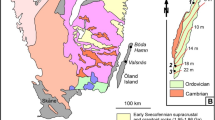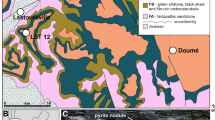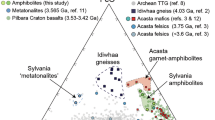Abstract
DESPITE the great economic importance of the stratigraphically concordant massive sulphide deposits which occur in regionally metamorphosed rocks of pre-Cambrian to Palaeozoic ages in all continents, little is known of their origin. Writers on these deposits, which include those of Mount Isa1, Broken Hill, the Scandinavian Cale-donides2, the Bathurst–Newcastle area3 and the Rhodesian Copperbelt, have tended to accept one of two apparently conflicting views. Some maintain that the deposits are syngenetic4, representing original sedimentary or volcanic sulphides, while others consider them to be epigenetic5, and formed by precipitation from hydrothermal solutions of igneous or metamorphic origin.
This is a preview of subscription content, access via your institution
Access options
Subscribe to this journal
Receive 51 print issues and online access
$199.00 per year
only $3.90 per issue
Buy this article
- Purchase on SpringerLink
- Instant access to full article PDF
Prices may be subject to local taxes which are calculated during checkout
Similar content being viewed by others
References
Solomon, P. J., Econ. Geol., 60, 737 (1965).
Vokes, F. M., Econ. Geol., 57, 890 (1962).
Boyle, R. W., Econ. Geol., 60, 1529 (1965).
Sales, R. H., Econ. Geol., 57, 721 (1962).
Garlick, W. G., Econ. Geol., 58, 447 (1963).
Strens, R. G. J., thesis, Univ. Nottingham (1962).
White, D. E., Anderson, E. T., and Grubbs, D. K., Science, 139, 919 (1963).
Manheim, F. T., Hathaway, J. C., Degens, F. T., McFarlin, P. F., and Jokela, A., Geol. Soc. Amer. Program Abstracts, 100A (1965).
Author information
Authors and Affiliations
Rights and permissions
About this article
Cite this article
ROBINSON, B., STRENS, R. Genesis of Concordant Deposits of Base Metal Sulphides: an Experimental Approach. Nature 217, 535–536 (1968). https://doi.org/10.1038/217535a0
Received:
Issue date:
DOI: https://doi.org/10.1038/217535a0



